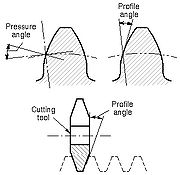
Angle of pressure
Encyclopedia

Profile angle
The profile angle of a gear is the angle at a specified pitch point between a line tangent to a tooth surface and the line normal to the pitch surface . This definition is applicable to every type of gear for which a pitch surface can be defined...
at the standard pitch circle and can be termed the “standard” pressure angle at that point. Standard values include 14.5, 20 and 25 degrees. Earlier gears with pressure angle 14.5 were more commonly used because for a given pressure angle, cosine would be larger for smaller angle, thus resulting in more power transmission and less pressure on the bearing. But for a given material, smaller pressure angles correlate with weaker teeth. To run gears together properly one must match pressure angles.
Just as there are three types of profile angles, there are also three types of corresponding pressure angles: the transverse pressure angle, the normal pressure angle, and the axial pressure angle.

